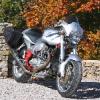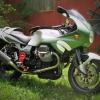Leaderboard
Popular Content
Showing content with the highest reputation on 04/20/2025 in all areas
-
This is correct, crankcase ventilation/oil vapor travel up from the back of the engine through the nefarious double-bend rubber hose under the frame to the bottom of the frame spine behind the headstock. The frame cavity acts as a separator with the gaseous fraction following the path @gstallons describes (a hose visible from the fitting on top of the frame spine, behind the headstock/ in front of the tank) to the airbox, and the liquid fraction draining down through the frame cavity to the return line and back into the sump. Ideally, adequate running temperatures will evaporate the water before it drains back into the sump. Less than ideal would be short operating times, very wet environs, and long storage periods. Also, oil selection plays a part. Pure synthetics (true ester base oils) have close to zero evaporation loss from heat and aid the efficiency of a complex, closed loop, crankcase ventilation system like ours.3 points
-
Note to all: Please recognize a proper response to a "wanted" topic as posted by @Pressureangle. Anyone receiving a "Personal Message" with an outside email to contact ("my buddy has one those " type-of-thing) should report that message by clicking the ellipsis ( . . . ) at the top right of the message and add any comments to the report. Thanks for helping keep door closed so the rats don't wander in!3 points
-
2 points
-
Could have stuck to history without the political commentary, but fundamentally good. Oh, and "The engines are identical" is at best misleading, and at worst, well, misrepresentation. Anybody who's ridden one knows it's not 170 horsepower, doesn't come on like a light switch- in fact, the powerband is much less abrupt than a Kawasaki Triple. Even if every part number in the engine is the same, the pipes and the porting make all the meaningful difference. On most 2-strokes, an hour by a professional and a tailored pipe can add 10-50% to any 2-stroke, depending on era and state of tune.2 points
-
2 points
-
As far as I understand it, that is the return that brings the re-condensed oil out of the frame back to the motor. The one that connects to the frame up near the steering head brings the vapours out of the crankcase into the frame. Please correct me if I am wrong.2 points
-
Since we touched on sound/video considerations I thought I'd start a conversation specifically about that. I had a GoPro a few years ago, video quality was good. Sound was shyte. Video editing software was not intuitive, data storage requirement was enormous- in the end, just gave the camera away. Got Innovv F&R cams on the 'Sport; video quality nearly as good, audio also shyte (neither had external mic port) direct-to-card recording at least made getting it into the PC easier. Editing software was generic, don't recall what it was. Still, not easy to use, add/subtract sound etc. So what's the easy answer? I see the cameras most common to vloggers, they still use GoPro but may have multiple brands (360 etc.) What are they using to put it all together? Ushuaia has been calling1 point
-
Well , you need to purchase a l.h.thread ball end and a threaded rod w/l.h. &r.h. thread and go to work. I will try to find some part #s. This is the best way to fix this so you can trim this height to suit you .1 point
-
Book it up to environmental protection. The air that comes out of the crankcase is heavy with oil vapour. It's better for the environment if the re-condensed oil goes back into the motor.1 point
-
Well, I had never dug into where those expansion chambers came about. All I know, is that I had a Gitane Testi when I was 14 years old, and I purchased the expansion chamber sold by Motori Minarelli for my 49.9cc engine. I knew the reason and the principle about it, but I never imagined it came from Germany.1 point
-
I've only replaced my vent hose once, but it really wasn't the source of my leak problems. Part of my issues was the #15 gasket for the oil pipe that the hose attaches to. (Notably, oil leak from this gasket appears at the 'weep hole" at the bottom of the clutch housing.)1 point
-
One of the difficulties assessing the system is that the vapor recovery (which would include water vapor) is not on the parts diagram for the ventilation system ("oil pump"), but on the "air filter" page (16-20) . . .1 point
-
Found these, not stock, certainly not cheap, but nice looking. https://www.ghezzi-brian.com/en/tuning-moto/tuning-moto-guzzi/v11-1100-sport-daytona-centauro/belly-pan/1 point
-
20mm. My sideplates including footpegs and pivot pins are scheduled for delivery tomorrow, I guess I'll delay leaving town for another day to keep curiosity from eating me while away.1 point
-
NOPE . I am wrong . there is a fitting and hose at the top of the frame (visible) at the front of the fuel tank and goes back to the air cleaner housing that vents to the inside of the housing. This keeps crankcase pressure from building up and ruining things . My apologies for the heresy.1 point
-
Mate, down here Rough as guts is being polite.... Shiraz time by the way ... Cheers1 point
-
The front brake hose going through the steering head took SOME effort1 point
-
I had to go look. Yes , it is that stupid . It should be vented to the atmosphere but it isn't . I know there is a screen in the return hose to keep debris out of the crankcase .1 point
-
1 point
-
@audiomick, that seems like a wonderful way to introduce water into the crankcase. Putting the vapors into a steel tube, then draining it back to the crankcase? I can see condensation happening in colder months.1 point
-
"In this country" is the point. Convertibles just don't make sense in Australia, even in Melbourne (in the south = further from the Equator = not as savage sun as further north). The sun is too strong in summer, and, particularly in Melbourne, it's mostly too cold in winter for open top driving. Here in Germany, I could imagine having one. Perhaps not in the absolute middle of summer, but in spring and autumn it would be pretty pleasant, I reckon.1 point
-
Sound and Video has always been, and still is, seperately recorded in film production. I'm pretty sure everyone here would have seen at least a photo of one of these at some point Filmtechniker 15:05, 24. Aug. 2008 (CEST) (Transferred by Heubergen/Originally uploaded by Filmtechniker), Copyrighted free use, via Wikimedia Commons It's purpose is exactly what "some people" achieve by honking the horn. Hold it in front of the camera (film cameras don't record sound) and bang the top bit together to make a short, sharp, distinct sound. Obviously a clapper board is not absolutely necessary, assuming you don't need the blackboard on the front to note take number, date, whatever. You can use two bits of wood, clap, bang two hedgehogs together, anything that makes a short and distinct sound and clearly shows the "moment of impact" on camera. Then, "all you have to do" is line up the sound with the picture in post-production. PS: I would use some variation of the clapper board even when using a camera that records sound. Experience shows that it is much, much easier to find a spot in an audio track if you have pictures to give you visual cues where you are up to in the recording. For instance: start the audio recorder, count seconds up to starting the camera, get sorted and clap in front of the camera. Find the pictures of the clap, look at the elapsed time, and you know where to look for the sound of the clap in the separate audio recording.1 point
-
1 point
-
I am always amazed at the wealth of info to be found here. The amount of detail that is written about some little part or connection on a Sport is impressive. I'm on it now, time to order parts. Thank you all!1 point
-
1 point
-
After chasing this issue for months, my wet sump return line was traced to spooge from the tank vent that was zip-tied to the return line . . .1 point
-
The fitting on that oil return line to the rear of the sump changed from the early AN fitting to the later (double) O-ring. I discovered, the long and hard way, that oil dripping from that line may well be coming from another source, though . . .1 point






